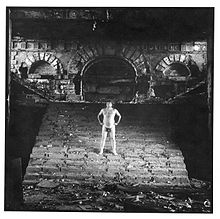Ed Kienholz
| Edward Kienholz | |
|---|---|

Edward Kienholz photographed by Lothar Wolleh, 1970
|
|
| Born |
October 23, 1927 Fairfield, Washington |
| Died | June 10, 1994 (aged 66) Hope, Idaho |
| Nationality | American |
| Education |
Eastern Washington College of Education Whitworth College "Self-taught" |
| Known for |
Installation art Assemblage |
| Notable work |
Roxy's (1961) The Illegal Operation (1962) Back Seat Dodge ’38 (1964) The Wait (1964-65) The State Hospital (1966) Five Car Stud (1972) |
| Movement | Funk art |
| Awards | Guggenheim Fellowship (1976) |
Edward Kienholz (October 23, 1927 – June 10, 1994) was an American installation artist and assemblage sculptor whose work was highly critical of aspects of modern life. From 1972 onwards, he assembled much of his artwork in close collaboration with his artistic partner and fifth wife,Nancy Reddin Kienholz. Throughout much of their career, the work of the Kienholzes was more appreciated in Europe than in their native United States, though American museums have featured their art more prominently since the 1990s.
Art critic Brian Sewell called Edward Kienholz "the least known, most neglected and forgotten American artist of Jack Kerouac's Beat Generation of the 1950s, a contemporary of the writers Allen Ginsberg, William Burroughs and Norman Mailer, his visual imagery at least as grim, gritty, sordid and depressing as their literary vocabulary".
Edward Ralph Kienholz was born in Fairfield, Washington, in the dry eastern part of the state. He grew up on a wheat farm, learning carpentry, drafting and mechanical skills. His father was strict, and his mother was a religious fundamentalist. but the rebellious son longed to escape this constricted environment. He studied art at Eastern Washington College of Education and, briefly, at Whitworth College in Spokane, but did not receive any formal degree. After a series of odd jobs, working as an orderly in a psychiatric hospital, manager of a dance band, used car salesman, caterer, decorator and vacuum cleaner salesman, Kienholz settled in Los Angeles, where he became involved with the avant-garde art scene of the day.
In 1956, Kienholz opened the NOW Gallery, for which Michael Bowen designed the sign; that year he met grad student Walter Hopps, who owned the Syndell Gallery. They co-organized the All-City Art Festival, then in 1957, with poet Bob Alexander, they opened the Ferus Gallery on North La Cienega Boulevard. The Ferus Gallery soon became a focus of avant garde art and culture in the Los Angeles area.
...
Wikipedia
